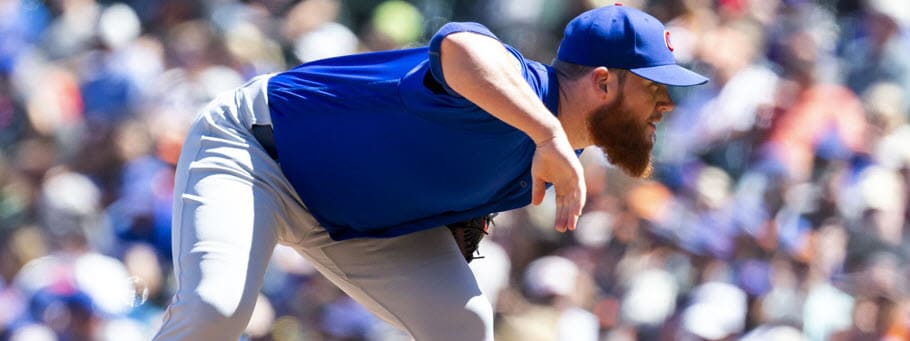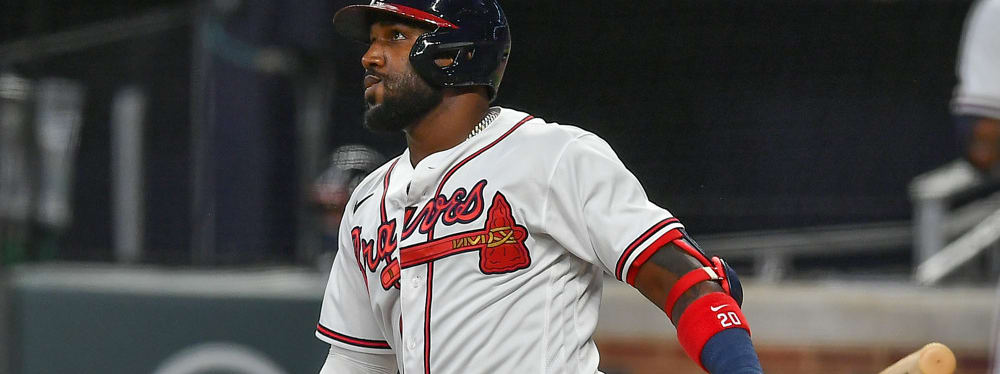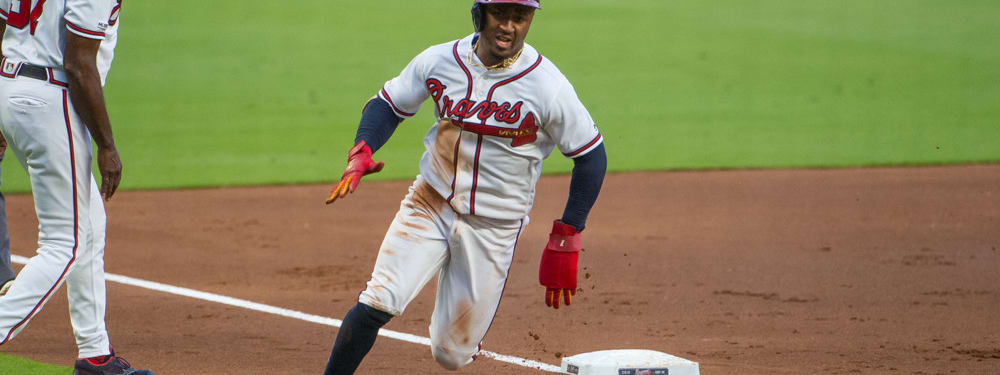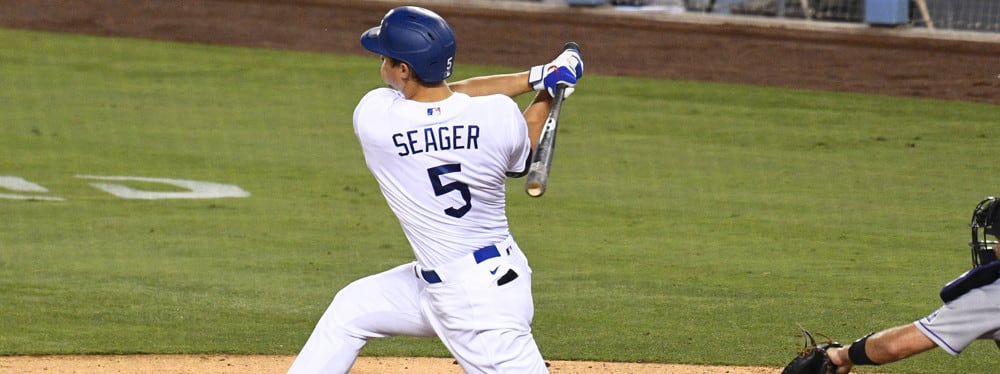Recent RotoWire Articles Featuring Nick Markakis
See More
Markakis has played at the major-league level for 15 seasons and has aged gracefully as a hitter who works counts and does not get himself into trouble chasing bad pitches. Throughout his 30s, he has been a double-digit walk rate guy with a high contact rate who hits above league average. He excelled as a run producer in 2018 for Atlanta with the approach and kept it up around injury in 2019. He first opted out of playing in the shortened 2020 season, but then came back when nobody really knew you could do that. The disruption of training clearly had an effect on him as he did little to contribute to Atlanta's offense in 2020. Markakis is now a free agent and unlikely needed in Atlanta, and if the universal DH is indeed being dropped for 2021, Markakis may just hang them up because his overall defensive skills are not aging as well.
Markakis has essentially been the definition of a league-average regular during his first five seasons in Atlanta, slashing .284/.359/.403 and generating a 103 wRC+ while providing passable defense in the corner outfield. While there's something to be said about Markakis' stable profile, his relative paucity of home-run and stolen-base production lowers his overall fantasy ceiling and instead makes playing time the primary driver of his value. After inking a one-year, $4 million deal to return for 2020, Markakis should retain a starting gig to begin the season, but he has less job security compared to previous years. If the Braves decide outfield prospects Drew Waters and/or Cristian Pache are ready for full-time run in the big leagues later this summer, Markakis could be pushed into a bench role.
An unbelievable first half (.323/.389/.488, 10 homers) earned Markakis his first career All-Star selection, in his 13th year in the big leagues. The beauty of baseball is that eventually, over a big enough sample, everyone reverts to their true baseline, and indeed Markakis went back to being Nick Markakis over the final two and a half months (.258/.333/.371, four homers). The final numbers were still quite good. His placement behind the likes of Ronald Acuna and Freddie Freeman in the batting order resulted in Markakis finishing top-25 in RBI. In fact, he helped a lot of people to championships as a late-round bench piece/injury replacement. He's maxed out with 155-plus games in each of the last six seasons and was under .277 in four of the previous five coming into 2018. The fear was that on a lesser team, in a worse spot in the order, Markakis' counting stats and fantasy utility would take a big hit, but he ended up returning to Atlanta on a one-year deal.
Markakis enters the final year of his four-year deal with the Braves as the organization's crop of young prospects moves closer to taking over at the big-league level. Despite an extreme lack of power, especially for a corner outfielder, Markakis was deployed predominantly in the heart of the order for Atlanta last season. Thanks to his ability to control the strike zone and spray the ball to all fields, Markakis is a viable run producer with a decent batting average floor (he hasn't hit worse than .269 in a season in his 12-year career). If the lineup around him continues to improve, it may come at the expense of his place in the batting order and overall volume of playing time. Entering his age-34 season, there's no reason to think the 20-homer pop he flashed early in his career with Baltimore is going to come back, even with the opportunity to play half of his games in a home park that boosted left-handed power in its inaugural year.
David Dellucci -- err, Markakis put forth another consistent offensive season. Looking at his weighted on base average (wOBA), he was in the .320 range for a third consecutive season. He got back to double digits in homers and went back to the fountain of his youth as a run producer, driving in more runs than he had in any of his previous six seasons. The problem with Markakis is that he does not do any one thing that well. He also does not do anything poorly. He plays nearly every day so he gets his chances to compile numbers, but RBI are a skill of opportunity, so those could disappear as quickly as they came back for him last year. If that happens, he's an everyday zero-category player, which is incredibly difficult to roster in mixed league formats, making him the equivalent of a possession receiver for fantasy baseball.
The power vanished for Markakis in his first year with Atlanta, as he managed only three home runs after reaching double digits in each of his nine seasons with Baltimore. However, the rest of his game was pretty much right in line with what we have come to expect, with Markakis striking out less than 13 percent of the time while walking at a 10 percent clip, and he reached 155 games played for the eighth time in the last nine years. His power is bound to tick back up to a certain extent in 2016 -- he had just a 2.1 percent HR/FB rate (8.4 percent career) -- but Markakis' pop is modest and he's managed a total of six steals in his last four seasons. The lack of home-run or stolen base numbers make him somewhat of an afterthought in drafts, but that makes for an intriguing profit margin. He's one of the least sexy outfield options out there, but that doesn't mean there's not value to be had as he will likely bat in the top third of the order again this year.
While Markakis didn't live up to the expectations befitting the six-year, $66.1 million contract he signed with the Orioles in 2009, only four players in the big leagues piled up more plate appearances than Markakis during that span. Settling in as the leadoff hitter in Baltimore, Markakis benefited from the quality of the lineup behind him, eclipsing 80 runs scored for the second straight year and swatting double-digit home runs for the ninth consecutive season. Defensively, he would profile better in left field than right, but the Orioles didn't have the luxury of moving him across the outfield in 2014. Most of Markakis' value comes from his aforementioned durability, but he's also shown the ability to put a lot of balls in play, striking out in just 13 percent of his plate appearances as a big league hitter. The Braves signed him to a four-year deal in December, and he will likely be used as the leadoff hitter in Atlanta in Year 1 with his new club, assuming his recovery from mid-December neck fusion surgery goes as expected.
Markakis suffered through the worst season of his career in 2013 with career lows nearly across the board. He actually produced a -0.1 WAR, marking the third consecutive year that his overall value has fallen, and the Orioles dropped him as low as seventh in the order late in the season. A second errorless season in the last three years might be a silver lining to Markakis, but not to his fantasy owners. Markakis enters a contract year and he will certainly be motivated to produce since the Orioles will be positioned to consider signing several other players. While he's still making contact at a steady clip, Markakis' .085 ISO last season was by far the lowest of his career.
Markakis had a bounceback season interrupted when he tweaked his wrist while swinging at a pitch in June, then his thumb was broken when he was hit by a pitch in early September. While he was healthy, Markakis improved his OBP and his slugging percentage from career lows in 2011. He also tallied 44 extra-base hits in 2012, just two less than his 2011 total despite getting 221 fewer at-bats. Markakis is a contact hitter and he had a career-best 26.8 percent line drive rate last season. If he can repeat that number he should be a .300 hitter. The Orioles no longer appear to be sold on Markakis as their No. 3 hitter and he was used in later months as the leadoff man, even though he had just one stolen base on the season. A healthy Markakis should return in 2013 and should be planted at the top of the order.
Markakis remains unable to recapture the magic of 2008, when he posted a .897 OPS, 20 HR and 106 runs. Markakis set a career low in OPS in 2011 with a .757 mark and continues to show shockingly little power. The 28-year-old finished with a .122 ISO, a below average mark for the second year in a row. He should be at or near 100 percent when spring training begins after suffering a bruised pelvis while diving for a ball late last season, but it's clear that 2010 and 2011 are more along the lines of what to expect as his slugging percentage has fallen in each of the last three seasons. He subsequently had surgery in January to repair an abdominal tear and will miss at least the first two weeks of spring training.
Markakis was a huge disappointment last season, but his power and RBI drop was at least in part attributable to the failure of others, notably Adam Jones' regression and the absence of Brian Roberts in the lineup in front of him. His batting average and contact rate have remained stable, he's still hitting doubles, and he walked considerably more last year. If Roberts can stay healthy and keep getting on base in front of Markakis, we'll see a recovery this year. We just may never ever see that power breakout that many were hoping for - his range in any given year is in the 15-25 area.
After signing a six-year extension prior to the start of the season, Markakis saw some of his numbers dip in 2009. He was more aggressive at the plate, cutting back on his walks from 2008. The effects were felt in a rise in RBI, but a drop in OBP and OPS. Meanwhile, after stealing just six bases it appears Markakis is no longer a threat on the basepaths. He's still a nice option for fantasy owners in the early-middle rounds, but the ceiling may not be as high for him as it once appeared.
Though Markakis produced some similar numbers to his 2007 season in 2008, he fell 25 RBI and eight stolen bases short of his previous totals. Although he hit second in the order more often, Markakis actually had better numbers nearly across the board in that situation. He did not take the next step with his power, but he gained more plate discipline by increasing his walks more than 50 percent which in turn helped his on-base percentage and OPS. Look for a similar season, but know that his ceiling is probably 30 HR, 110 RBI and 20 SB.
The Orioles justifiably get a lot of grief over their failures to draft and develop major league talent, but Markakis has gone a long way towards helping them shake that reputation. They were bold to promote Markakis out of spring training in 2006 with only 33 games of Double-A experience, but that gamble has paid off, both at the plate and in the field. Once again, he turned on the power over the second half of the season, hitting 14 homers and slugging .550 after the break.
The Orioles stuck with Markakis after a slow start to the season, when he unexpectedly earned a spot after spring training, and the decision paid off in spades. After the All-Star break, Baltimore's top prospect hit .311/.364/.532 with 14 homers and 41 RBI in 267 at-bats. Translated over the entire season, that would yield 29 homers and 85 RBI. Moreover, Markakis spent most of the season batting in the No. 9 spot, and is expected to hit in the No. 3 spot in 2007 behind Brian Roberts and Melvin Mora and in front of Miguel Tejada. The 23-year-old should break out big time in 2007.
Markakis is the new golden boy of the Baltimore organization, living up to his preseason billing as the team's top prospect by raking in Single-A and Double-A, batting .310 with 15 homers and 92 RBI. He continued his success in the Arizona Fall League with a .326 average and .408 OBP in 86 at-bats. What's scary is that Markakis was converted to an outfielder from a pitcher not too long ago, and still has room for improvement. He'll likely spend most of the next season in Triple-A, and could see time as an injury replacement or September call-up if he continues to hit well and adds a little power to his stroke.
Markakis was Baltimore's No. 1 pick in the 2003 draft. He hit well for Greece in this summer�s Olympics, and had a successful season at low Single-A Delmarva. He�ll likely spend most of 2005 with high Single-A Frederick and is at least a couple years away.
Markakis was Baltimore's No. 1 pick in the 2003 draft. He was a pitcher/outfielder at junior college, but the O's see him as an outfielder. He had some success, but limited power, for Single-A Aberdeen and was named the top prospect in the New York/Penn League. He's still about three years away.












